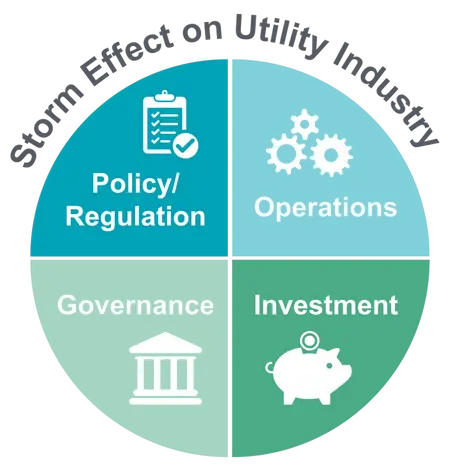
What happened in February?
In February, an unprecedented winter storm covering most of the U.S. shut down many electric generation resources. Power blackouts occurred and the electric supply was drastically reduced at the same time as winter demand hit record levels. This necessitated rotational load shedding as a last-resort measure to avoid a total blackout of the power grid.
What has happened since then?
Operationally, all sectors of the power industry have examined the events and their response to them to determine lessons learned and ways to extend the resilience of the grid. Quickly, a new focus has developed on “winterizing equipment” and preparing for all types of severe weather conditions. This emphasis is extending across most utility operational areas, including generation, transmission & distribution, and customer services. Specific to infrastructure services, such as design, engineering, and construction, new project specs are being developed to incorporate redundancy and resilience measures.
On the regulatory front, several federal and state entities are reviewing the bulk-power system’s operations during this extreme weather event. Changes in regulations across the spectrum are expected to result.
Power costs skyrocketed on the Texas wholesale market when the power plants went offline, this substantially reduced energy supplies. As a result, the financial hit rippled through the sector, from insolvent power co-ops to electric retailers to consumers, all of whom are now faced with astronomical bills.
An avalanche of litigation has been filed across the country including several class action lawsuits against all entities within the sector, including utilities. Several jurisdictions have sought criminal indictments against officials involved.

The events of February are much wider spread than first thought and have the potential to shape utility policy, regulation, operation, governance and investment … literally all aspects of the utility spectrum.
Consider these observations:
- The grid failure was a risk management issue. Understanding and containing multi-dimensional risk, such as material supply risk, outage management, emergency response and customer service interactions will be key to protecting and preparing utility operations. Supplier competency and resilience measures are key supply chain contributions.
- Disaster planning scenarios that stress-test all phases of operations are a key component. Proper levels of supplies, prior to, and during a crisis often make the difference between good and bad outcomes. This includes typical grid repair equipment like transformers, wire, and fuses but also PPE like warm winter gloves, hand warmers and windbreaks as well as bottled water and rations. Supply chains must be at the forefront of disaster planning to properly prepare and support operations in quickly unfolding situations.
- Utility operations are a large system, and system testing teams (IT and other components) must be heavily incorporated into planning scenarios. Mission critical technology, such as distribution management Systems or supervisory control and data acquisition systems, should be included in cascading failure drills. The Supply Chain should be represented on these testing teams, and response planning should consider second-degree validations of conditions.
- Regulatory impacts may result from investigations across several jurisdictions. The importance of a fully functioning, risk-measuring supply chain was elevated in 2020 and reinforced recently during the grid failure. Procurement teams must monitor the regulatory proceedings to anticipate the infrastructural areas of greatest impact and to prepare for additional grid hardening, operational expansions and construction projects that could be widespread. These extensive construction projects could result in significantly constrained supplier sectors. Start now to assemble Engineering Procurement and Construction (EPC) contractors, expand stock levels, review warehouse and storage locations as well as logistics and freighting measures.
What’s next?
The issues around the February 2021 failures are complex, and investigators will most certainly have a lot to untangle. This is an area that will need close monitoring nationwide… as this unfolds, there is potential for materially changed utility operations. The key moving forward will be recognizing risks across a wide spectrum and developing integrated mitigation measures to address them; especially with extreme weather events that seem to be occurring more frequently.
As was seen during all of 2020, Supply Chain is at the forefront in responding to challenges of all kinds and has earned new respect throughout the corporate and community environments. Procurement teams routinely provide detailed coordination of complex purchasing and delivery operations involving many people, facilities, and supplies. With severe weather and other unexpected events becoming more commonplace, Supply Chain and Procurement have a unique opportunity to build on those successes and leverage their logistical experience to lead their organizations to a new level of preparedness.
Subscribe to Arroyo Strategy Insights to access whitepapers, presentations, plus our latest thought leadership.


